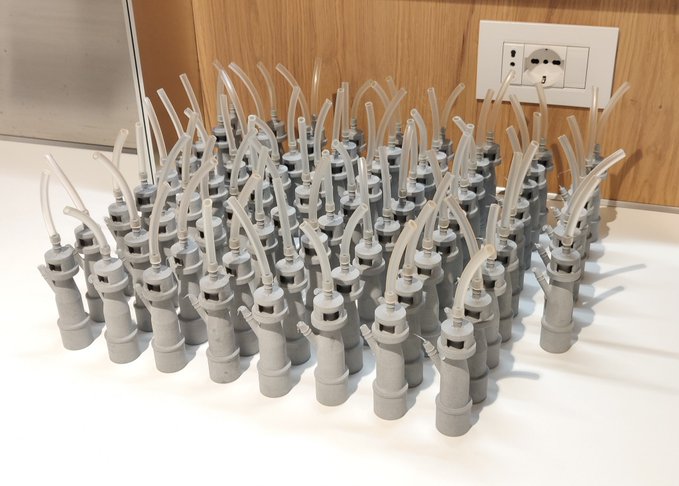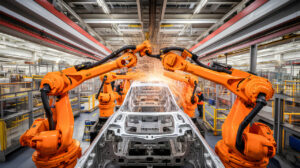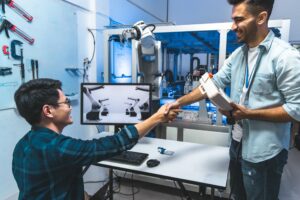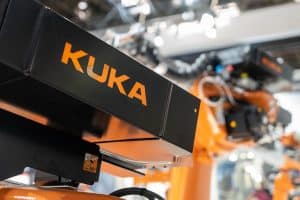It’s been a crazy week around the world amidst concerns of the novel Coronavirus (COVID-19). And while Learn Robotics isn’t a news outlet, I did want to spend some time talking about the behind-the-scenes automation that is helping us through these times.
If you are looking for a news source to help you get through the Coronavirus, check out Morning Brew. Over 1.8 Million people start their day with the latest news from Wall Street to Silicon Valley. Subscribe for free and get the daily email that makes reading the news actually enjoyable.
Automation Has our Backs During Coronavirus
In this article, we’re going to share how automation is helping us during the Coronavirus crisis. With people staying home from work, we have to rely on robots and automation more than ever. We’ve seen this in the past weeks as inventory for face masks, hand sanitizer, disinfecting wipes, and toilet paper has dwindled.
As a result, I thought it would be interesting to highlight some of the technical efforts going on in factories and in manufacturers around the world to help us restock supplies and continue the fight against COVID-19.
Furthermore, I’ve included links to articles and videos in case you’re interested in how these engineering efforts originated. Feel free to add a comment below with relevant robotics and technical stories in the efforts to combat the Coronavirus.
Please note that irrelevant and fear-mongering comments will be deleted, as this is a robotics-focused website, and we’re only providing this article as a means of educating you on automation topics.
Toilet Paper Lines
Did you run out of toilet paper yet? If you live in Australia, you might be in luck. An Australian newspaper printed out eight extra pages in a recent edition to serve as emergency toilet paper.
YES, WE ACTUALLY DID PRINT IT #toiletpapercrisis pic.twitter.com/jusP50ojYu
— The NT News (@TheNTNews) March 4, 2020
As much as I enjoy toilet humor (lol), the real reason why I’m bringing this up is that toilet paper manufacturing is a highly automated process. You can learn more about it in the National Geographic video below.
And with the process using about 27,000 trees per day (yikes), you might want to consider only buying what you need and not stockpiling it when it does make its way back on shelves.
Thanks to automation, toilet paper isn’t something we’re going to stop receiving anytime soon. It just might take a few weeks to see it readily available at your neighborhood store.
Help Create iFixit Guides for Repairing Medical Equipment
The popular repair guide website, iFixit, is calling on the public for help putting together repair guides for ventilators and other hospital equipment. As we see an increase in COVID-19 patients, the number of repairs on medical equipment is also expected to increase.
The goal of this project is to translate repair manuals into a collection of easy-to-read repair guides. That way we can minimize the number of machines that have to be taken out of service for repair.
If you’re interested in helping with this project, the first step is to find service manuals for medical equipment. Then upload them according to their website guidelines. More details can be found on the iFixit Crowdsource Repair page.
Automation Lines are Being Repurposed in Response to COVID-19
Many popular manufacturers are repurposing automation lines to help with the production of face masks and ventilators. Razer has devoted some of its manufacturing lines to produce surgical masks, according to a Twitter thread from CEO Min-Liang Tan.
https://twitter.com/minliangtan/status/1240529768195350528
Sharp, the TV Manufacturer, will also start producing as many as 500,000 masks per day. Elon Musk (and his empire) are also willing to help amid the Coronavirus crisis by having both Tesla and SpaceX produce ventilators as needed.
We will make ventilators if there is a shortage
— Elon Musk (@elonmusk) March 19, 2020
Additionally, automotive factories including GM and Ford are also looking into whether they can be used to make medical supplies in response to the Coronavirus.
Remote & Virtual Work Environments
Nearly everyone is getting a taste of what the remote lifestyle is like. With companies closing their doors and setting up virtual work environments, it’s a lot for everyone to get used to. If you haven’t gotten the “all clear” to work from home yet, and you are in engineering, you may fall into a role that requires you to be on-site.
According to a Control Engineering poll, “not everyone can work at home. Remote working doesn’t work for everyone, as 45% said they can complete critical…job functions at home, 31% cannot, and 24% were not sure.”
Furthermore, the impact of COVID-19 is forcing manufacturers to rely more on automation and digitalization for long-term operations. And, “even in the wake of COVID-19, manufacturers still need human workers to manage the supply chain.” Adding automation to supply chain and operations could become a big opportunity for manufacturers in the coming months.
3D Printed Valves

Finally, we saw the work of reverse engineering come into play when a hospital in Italy ran out of important ventilator valves.
The original manufacturer wasn’t able to produce enough of these valves in time to treat patients, so an Italian startup, Isinnova, offered to develop and 3D print a replica part.
While there are mixed reports of an impending lawsuit over patent infringement of the original valves, according to The Verge, the 3D replica parts worked on 10 patients as of March 14th. This just goes to show how engineering and additive manufacturing can come to the rescue in times of urgent need.
You can read more about this story on Tech Dirt, The Verge, and via the Business Insider – Italy.
Did you see an interesting story on how automation is helping us during Coronavirus? Leave a comment below and be sure to link to the source.





